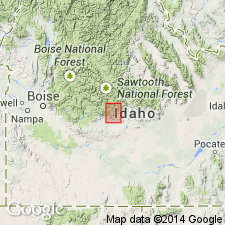
- Usage in publication:
-
- Challis volcanics*
- Modifications:
-
- First used
- Dominant lithology:
-
- Lava
- Tuff
- Pyroclastics
- AAPG geologic province:
-
- Idaho Mountains province
- Snake River basin
Summary:
March, 1930. Challis volcanics. Lava flows and associated pyroclastics of probable Miocene age in mountain region of south-central Idaho. Mapped in Custer and Camas Counties, Idaho. In Custer County, two small bodies of Miocene(?) lava assigned to Challis on map of Seafoam mining district; mapped as lava flows and pyroclastics in Alder Creek mining district. Tuff is of silicic and intermediate composition. In mining districts, Challis is younger than the Jurassic or Cretaceous granitic rock and younger than the Miocene(?) porphyry or the Pliocene Snake River basalt. Report includes geologic maps.
Named for Challis National Forest and town of Challis, Custer Co., ID.
Source: US geologic names lexicon (USGS Bull. 896, p. 394); supplemental information from GNU records (USGS DDS-6; Denver GNULEX).
- Usage in publication:
-
- Challis volcanics*
- Modifications:
-
- Revised
- Age modified
- AAPG geologic province:
-
- Idaho Mountains province
Ross, C.P., 1932, Idaho correlation chart, compiled by G.C. Wilmarth, September, 1932: U.S. Geological Survey, 1 sheet., Chart to accompany USGS Bull. 896, 1938
Summary:
Challis volcanics. Divided into (descending): (1) tuffaceous beds present in places; (2) Yankee Fork rhyolite member, 0 to 1,600+/- feet; (3) Germer tuffaceous member, 0 to 2,000+ feet; (4) andesitic beds, 0 to 2,000 feet. Age is Oligocene(?). Unconformably underlies Miocene intrusives and unconformably overlies intrusives related to Idaho batholith.
[GNC remark (ca. 1934, US geologic names lexicon, USGS Bull. 896, p. 394): More fully described by C.P. Ross in USGS Bull. 854, 1934, on Casto quadrangle.]
Source: US geologic names lexicon (USGS Bull. 896, p. 394).
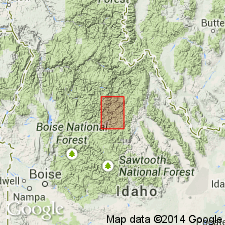
- Usage in publication:
-
- Challis volcanics*
- Modifications:
-
- Named
- Dominant lithology:
-
- Tuff
- AAPG geologic province:
-
- Idaho Mountains province
Summary:
Pg. 46-53, pl. 1. Challis volcanics. Comprises all Tertiary volcanic rocks in Casto quadrangle except Snake River basalt. Includes Yankee Fork rhyolite member (new) above main mass, 500 to 1,000 feet thick. Consists of lava flows and tuffs of rhyolite and quartz latite composition. Each flow a little different; some are more calcic, most are glassy, devitrified, nonporphyritic, and generally spherulitic. Some of tuff is water-laid and has scattered pebbles. No complete section exposed. Thicknesses: 3,400+ feet along trail on Camas Creek below Meyers Cove; 1,482 feet on south side of Merino Creek. Overlies Casto volcanics. No fossils found in quadrangle. Fossil plant remains, found in Lemhi Valley, Lemhi County, Idaho, are of late Oligocene or early Miocene age. For present Challis is regarded as Oligocene(?). Report includes geologic map.
Type locality not designated. Named for town of Challis, Custer Co., ID.
Source: US geologic names lexicon (USGS Bull. 1200, p. 710); supplemental information from GNU records (USGS DDS-6; Denver GNULEX).
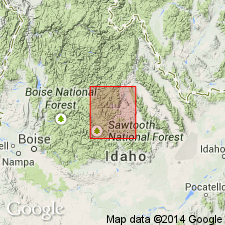
- Usage in publication:
-
- Challis volcanics*
- Modifications:
-
- Revised
- AAPG geologic province:
-
- Idaho Mountains province
Summary:
Challis volcanics. Comprises thick, widespread Tertiary (upper Oligocene or lower Miocene) volcanic strata in Bayhorse quadrangle, Custer County, Idaho. Varies in character from place to place. Includes Germer tuffaceous member (new) of the Germer basin, T. 12 N., R. 19 E., Custer County, Idaho. Germer consists of tuff, tuffaceous sandstone and some conglomerate and shale; contains plants, invertebrates, fish, and insect remains (fossils listed). Other Challis units include latite-andesite member, Yankee Fork rhyolite member, travertine, and basalt. Report includes geologic map.
Source: Modified from GNU records (USGS DDS-6; Denver GNULEX).
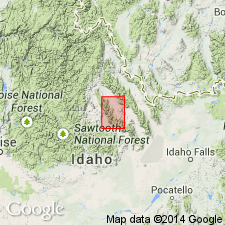
- Usage in publication:
-
- Challis volcanics*
- Modifications:
-
- Areal extent
- AAPG geologic province:
-
- Idaho Mountains province
Summary:
Pg. 1095, 1120-1120, pl. 1. Challis volcanics. Described in Borah peak quadrangle. Divided into (ascending) latite-andesite member, about 1,000 feet; basalt and related flows, about 2,500 feet; and Germer tuffaceous member, from knife-edge to over 500 feet. Locally succeeded by Donkey fanglomerate (new).
Source: US geologic names lexicon (USGS Bull. 1200, p. 710).
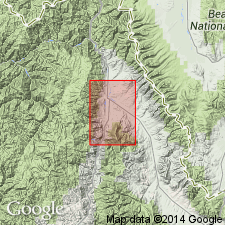
- Usage in publication:
-
- Challis volcanics*
- Modifications:
-
- Areal extent
- AAPG geologic province:
-
- Idaho Mountains province
Summary:
Pg. 18-28, pl. 1. Age given as Oligocene for exposures in Salmon quadrangle. As in other localities, the formation can be subdivided into units of somewhat variable composition, recognizable as equivalent to similar units in other parts of the region. Yankee Fork rhyolite member missing. Ignimbrites not common. Underlies Carmen formation (new).
Source: US geologic names lexicon (USGS Bull. 1200, p. 710).
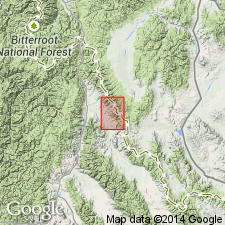
- Usage in publication:
-
- Challis volcanics
- Modifications:
-
- Areal extent
- AAPG geologic province:
-
- Idaho Mountains province
Summary:
Pg. 16. Challis volcanics. In Baker quadrangle, Lemhi County, Idaho, unconformably underlies upper Oligocene(?) Kenney formation (new). Age is Oligocene. Report includes geologic map.
Source: US geologic names lexicon (USGS Bull. 1200, p. 710); supplemental information from GNU records (USGS DDS-6; Denver GNULEX).
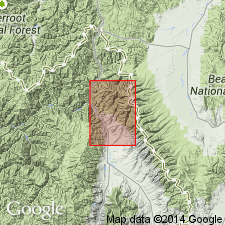
- Usage in publication:
-
- Challis volcanics
- Modifications:
-
- Areal extent
- AAPG geologic province:
-
- Idaho Mountains province
Summary:
Pg. 15, 22-25. Challis volcanics. In North Fork quadrangle, unconformably overlies Kriley formation (new) and underlies Greerston beds. Thickness 0 to 800 feet. Age of Challis still under study.
Source: US geologic names lexicon (USGS Bull. 1200, p. 710).
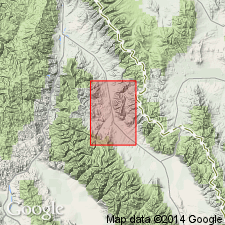
- Usage in publication:
-
- Challis Volcanic group
- Modifications:
-
- Revised
- AAPG geologic province:
-
- Idaho Mountains province
Summary:
Challis Volcanic group. Rank raised to group. Divided into three newly named formations (ascending): (1) Cheney Volcanics (middle Oligocene), latite and andesite; (2) Yearian Volcanics (upper Oligocene), pyroclastics, basalt and basic andesite; and (3) Kadletz Volcanics (lower(?) Miocene), basaltic rocks. Report includes geologic map, cross sections.
Source: Modified from GNU records (USGS DDS-6; Denver GNULEX).
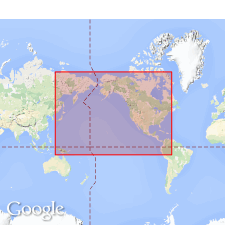
- Usage in publication:
-
- Challis Volcanics*
- Modifications:
-
- Overview
- AAPG geologic province:
-
- Idaho Mountains province
Summary:
USGS currently [ca. 1966] designates the age of the Challis Volcanics as Eocene(?), Oligocene, and early Miocene(?) on the basis of a study now in progress.
Source: US geologic names lexicon (USGS Bull. 1200, p. 710).
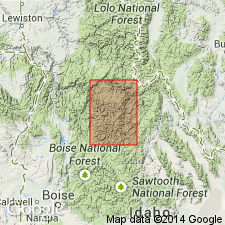
- Usage in publication:
-
- Challis Volcanics*
- Modifications:
-
- Geochronologic dating
- Age modified
- AAPG geologic province:
-
- Idaho Mountains province
Summary:
Challis volcanics. Altered rocks formerly thought to be part of Permian(?) Casto Volcanics (†Casto abandoned) are reallocated to Challis Volcanics. Age considered to be Eocene rather than Paleocene(?), Eocene, and Oligocene. Age determination based on 49.0 Ma (rhyolite), 45.5 Ma (quartz latite), and presence of Eocene flora. Report area in Custer and Valley Counties, Idaho.
Source: Modified from GNU records (USGS DDS-6; Denver GNULEX).
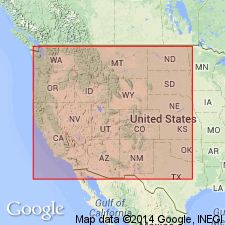
- Usage in publication:
-
- Challis Volcanics*
- Modifications:
-
- Geochronologic dating
- AAPG geologic province:
-
- Idaho Mountains province
Summary:
Pg. 17, geologic time scale (inside front cover). Challis Volcanics. Samples from "Rhyodacite of Upper Second Creek" and from brecciated margin of "Rhyolite flows at Mill Creek Summit" (both reversed magnetic polarity), in Clayton 7.5-min quadrangle, Custer County, Idaho, yielded K-Ar ages of 49.2 +/-1.2 Ma and 48.5 +/-1.2 Ma (biotite), respectively. Indicate age of volcanism; ages consistent with present stratigraphic interpretation. [Eocene, based on time scale of Berggren, 1972, Lethaia, v. 5, no. 2, p. 195-215.] Sample from rhyolitic ash-flow tuff interbedded with rhyodacite flows, on north slope of John Gulch, Bayhorse quadrangle, Custer County, Idaho, yielded a K-Ar age of 42.8 +/-1.0 Ma (sanidine); age too young if recently mapped stratigraphic relationships are correct. Ages calculated using decay constants of Steiger and Jager, 1977 (Earth Planet. Sci. Letters, v. 36, p. 359-362).
Source: Publication.
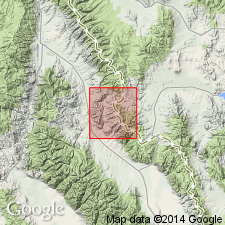
- Usage in publication:
-
- Challis Volcanics*
- Modifications:
-
- Geochronologic dating
- AAPG geologic province:
-
- Idaho Mountains province
Summary:
Challis Volcanics. Sample from crystal tuff in "tuff of Curtis Ranch," in upper part of Challis Volcanics, in NW/4 SW/4 sec. 19, T. 19 N., R. 25 E., Lemhi Pass thorium district, Lemhi County, Idaho, yielded K-Ar ages of 42.3 +/-1.4 Ma (biotite) and 40.3 +/-1.4 Ma (sanidine). These, and previously published ages, suggest Challis is Paleocene(?) and Eocene. Report includes geologic map.
Source: Modified from GNU records (USGS DDS-6; Denver GNULEX).
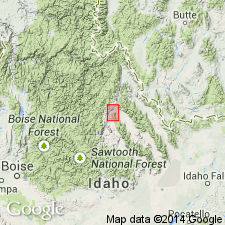
- Usage in publication:
-
- Challis Volcanics*
- Modifications:
-
- Revised
- AAPG geologic province:
-
- Idaho Mountains province
Summary:
Challis volcanics. In the northernmost part of the Lost River Range and adjacent Salmon River Mountains, Custer County, Idaho, overlies newly named Lawson Creek Formation; 4 localities discussed.
Source: Modified from GNU records (USGS DDS-6; Denver GNULEX).
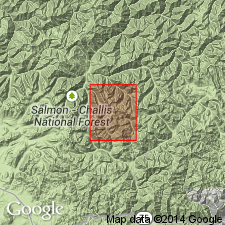
- Usage in publication:
-
- Challis Volcanics*
- Modifications:
-
- Revised
- AAPG geologic province:
-
- Idaho Mountains province
Summary:
Challis Volcanics (Eocene). †Yankee Fork Rhyolite Member abandoned; name fallen into disuse. Three map units (Tic, intrusive complex; Tdc, dome complex rocks; and Tdi, Tdc, dome intrusive rocks) were formerly considered part of the Yankee Fork.
Source: Modified from GNU records (USGS DDS-6; Denver GNULEX).
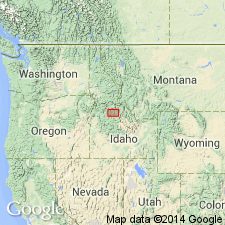
- Usage in publication:
-
- Challis Volcanics*
- Modifications:
-
- Overview
- AAPG geologic province:
-
- Idaho Mountains province
Summary:
Challis Volcanics. Includes lower latitic unit, 400 to 500 m thick, age 48.3 to 50.8 Ma; upper rhyolitic unit, 1,000 to 1,100 m of rhyolitic pyroclastics, rhyolite flows, andesite, sandstone, and granodiorite-bearing mudflow debris; Sunnyside rhyolite, local term used in the mining district for a 200+ m thick rhyolite crystal tuff to welded tuff, age 46 to 47 Ma; Dewey beds, local term used in the mining district for a 90 m thick water-laid conglomerate, volcanic sandstone, mudstone, carbonaceous shale, and lignite with Eocene plant fossils; and a latitic flow unit. Age is Eocene. Eruption began about 50 Ma and lasted 7 m.y.; Casto pluton intruded the east side of Thunder Mountain caldera about 46 to 47 Ma.
Source: Modified from GNU records (USGS DDS-6; Denver GNULEX).
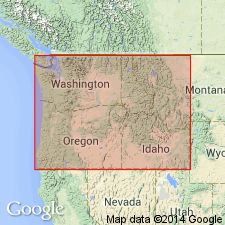
- Usage in publication:
-
- Challis Volcanics*
- Modifications:
-
- Geochronologic dating
- AAPG geologic province:
-
- Idaho Mountains province
- Central Western Overthrust
Summary:
Pg. 4, 5, 6, 7, 8, 9, geologic time scale (inside front cover). Challis Volcanics. Fourteen samples analyzed; ages calculated using decay constants of Steiger and Jager, 1977 (Earth Planet. Sci. Letters, v. 36, p. 359-362). [Age considered Eocene (from Geologic Names Committee, USGS, 1983 ed. geol. time scale, with additions from N.J. Snelling, 1985, The Geol. Soc. Mem., no. 10).]
Samples from welded latite tuffs, lava flows, and latite flows in basal part of Challis Volcanics, in Big Chief Creek, Edwardsburg, Yellow Pine, and Wolf Fang 7.5-min quadrangles, Valley County, Idaho, yielded K-Ar ages: on plagioclase 50.3 +/-3.1 Ma, 47.1 +/-5.6 Ma, and 43.5 +/-3.0 Ma (too young); on hornblende 72.4 +/-12.8 Ma (spurious) and 48.3 +/-2.8 Ma; and on whole-rock 46.3 +/-1.5 Ma (too young) and 43.3 +/-1.4 Ma (too young). Age of basal Challis probably 51 to 50 Ma. Data from Leonard and Marvin, 1982 (Idaho Bur. Mines. Geol. Bull., no. 26, p. 23-41).
Samples from basal breccia unit and porphyritic pumiceous vitrophyre (dacite), in Grouse 15-min quadrangle, Custer County, Idaho, yielded K-Ar ages of 49.3 +/-0.7 Ma (hornblende) and 47.6 +/-2.1 Ma (biotite), respectively.
Rhyodacite tuff sample from Scott Peak 15-min quadrangle, Clark County, Idaho, yielded a K-Ar age of 47.0 +/-1.3 Ma (biotite). Data from B.A. Skipp, 1984 (USGS Misc. Field Stud. Map MF-1601-B); tuff previously included in Medicine Lodge Volcanics by Scholten and others 1955 (GSA Bull., v. 66, no. 4).
Samples from "Sunnyside rhyolite," in Safety Creek 7.5-min quadrangle, Valley County, Idaho, yielded: K-Ar ages of 46.3 +/- 1.1 Ma and 46.3 +/-1.0 Ma (sanidine), and 47.7 +/-1.6 Ma (biotite); fission-track age on zircon 40.6 +/-4.6 Ma (too young). Age probably 47 to 46 Ma. Data from Leonard and Marvin (1982).
Samples from black, aphanitic latite flows interbedded with explosive rubble, from minor volcanic center at Lookout Mountain, in Monument, Rainbow Peak, and Safety Creek 7.5-min quadrangles, Valley County, Idaho, yielded K-Ar ages (whole-rock): 43.4 +/-1.4 Ma, 41.0 +/-1.4 Ma, 40.3 +/-1.8 Ma, and spurious 27.5 +/-0.9 Ma and 17.0 +/-0.6 Ma. Glass content ranges from 3 to 63 percent. Minimum age of youngest flow considered to be 43 Ma. Data from Leonard and Marvin (1982).
Source: Publication.
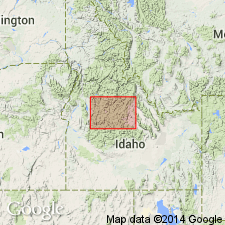
- Usage in publication:
-
- Challis Volcanic Group
- Modifications:
-
- Mapped 1:250k
- Revised
- Geochronologic dating
- AAPG geologic province:
-
- Idaho Mountains province
Summary:
Pg. 2-4, 30-33 (pamphlet). Challis Volcanic Group. Mapped in portions of Boise, Custer, Valley, and Lemhi Counties, Idaho. Includes informal Sunnyside tuff of Shannon and Reynolds (1975, Idaho Bur. Mines Geol. Inf. Circ., no. 29), formerly restricted to Thunder Mountain mining district. The †latite-andesite member and †Germer Tuffaceous Member (abandoned) have fallen into disuse and do not adequately describe the stratigraphic relations as currently understood. Age is Eocene; K-Ar ages range from 51.1 +/-1.8 Ma to 36.7 +/-1.5 Ma.
Source: Publication.
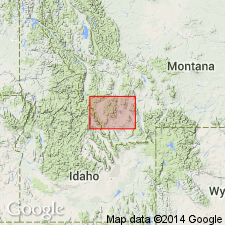
- Usage in publication:
-
- Challis Volcanics*
- Modifications:
-
- Mapped 1:250k
- AAPG geologic province:
-
- Idaho Mountains province
Summary:
Challis Volcanics. Present only in southwestern and west-central parts of quadrangle, in Lemhi County, Idaho. Consists of basaltic andesite, andesite, latite, rhyodacite, and rhyolite as flows, ash-flow tuffs, and tuff and flow breccias. Thickness less than 200 m in most places. In Withington Creek caldera, at northern end of Lemhi Range, comprises massive ash-flow tuffs at least 600 m thick that pass laterally across caldera margin into 50 to 100 m thick thinly layered ash-flow tuffs and andesitic flows. Age is Eocene; probably about 45 to 40 Ma (citing Staatz, 1979, USGS Prof. Paper 1049-A, p. 12-23, and Ruppel and Lopez, 1984, USGS Prof. Paper 1278).
Source: Publication.

- Usage in publication:
-
- Challis Volcanic Group
- Modifications:
-
- Mapped 1:24k
- AAPG geologic province:
-
- Snake River basin
Summary:
Challis Volcanic Group. In Mahoney Butte quadrangle, Smoky Mountains, Blaine County, Idaho, consists of rhyodacite dikes, dacite lavas, andesite plugs, andesite flows, tuff breccias, and sedimentary rocks. Divided into several informal volcanic and sedimentary map units; many are equivalent to or same as units of Worl and others (1991, USGS OFR-91-340, scale 1:250,000). Unconformably underlies Quaternary deposits; unconformably overlies Carboniferous rocks, and in places Upper Cretaceous Idaho batholith. Age is Eocene.
Source: Publication.
For more information, please contact Nancy Stamm, Geologic Names Committee Secretary.
Asterisk (*) indicates published by U.S. Geological Survey authors.
"No current usage" (†) implies that a name has been abandoned or has fallen into disuse. Former usage and, if known, replacement name given in parentheses ( ).
Slash (/) indicates name conflicts with nomenclatural guidelines (CSN, 1933; ACSN, 1961, 1970; NACSN, 1983, 2005, 2021). May be explained within brackets ([ ]).

